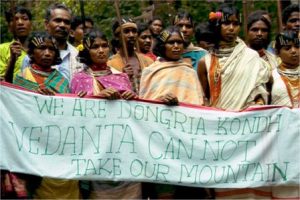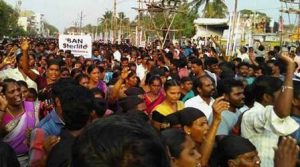Of Public Purpose, Land Conflicts and Human Casualties
Two of the safeguards, obtaining consent and Social Impact Assessment (SIA), under the Land Acquisition Act, 2013 are circumvented by the scope of “public purpose”.

In India, the reports of land conflicts and human rights violations by businesses and the state are a major concern to be addressed. Recent years have seen the country skewing towards a path of “development” in contravention to the basic needs of the people. It is evident from the way people protest and resist violations on their lands.
The recent instance of acquisition for high-speed rail link to connect the financial hub of Mumbai to Ahmedabad which led to wide resentment and protests has brought to question the definition of ‘public purpose” once again.
The Right to Fair Compensation and Transparency in Land Acquisition Rehabilitation and Resettlement Act, 2013 (also called Land Acquisition Act, 2013) was enacted after long years of demand to reform the former laws on the subject. The need for this law, LAA 2013, was felt after the 44th Amendment Act of the Constitution in 1978 repealed Article 19(1) (f) and 31, with the effect that right to property is no longer a fundamental right under the Constitution.
Under the act, land acquisitions for various projects are undertaken by the government. It may be for a public sector undertaking or for a private party as long as it is done for “public purpose”.
“This term, “public purpose” is defined very broadly under Section 2(1) of the LAA, 2013. Mainly it emanates from the concept of eminent domain or the sovereign power of the State over land and natural resources.”
This means, the government has the power to acquire and control any land directly without seeking the consent of the people affected. Further, when land is acquired for private companies, prior consent of at least 80 per cent of the affected families is required, and when it is acquired for public private partnership projects, the consent of at least 70 per cent of the affected families is to be taken.
However, recent trends show that in the name of industrialisation, large portions of land are being acquired from people for “public purpose” and “development” by the government and later handed over to private companies.
This fact becomes significant provided two of the safeguards, obtaining consent and Social Impact Assessment (SIA) under the act are circumvented by the scope of “public purpose”.
Even in the past, according to a study in 2012, the example of how the West Bengal Government acquired fertile agricultural lands in West Medinapur for the Tata Metaliks Company in 1992, dispossessing small and marginal farmers, even when equally-suitable waste land was easily available shows how the lack of consent and SIA can lead to gross injustice.
Also read:Time to assert land rights as human rights
Further, when it comes to land which is not particularly owned by any persons, i.e. Forest lands and Non-forest common lands, the situation is worse. According to 2011 census data, Adivasis or tribals constitute 8.6 per cent of the total Indian population. Though they are a minority in India, their number is by far larger than in many other countries. It is considered that the lack of property rights has led to gross injustice towards this community whose lives traditionally revolved around forest and forest products.
“As a result, it is estimated that 40 per cent of all the people displaced by government projects are tribal people in the country.”
The one legislation which recognises their rights towards the forest land is Scheduled Tribes and Other Traditional Forest Dwellers (Recognition of Forest Rights) Act, 2006 better known as Forest Rights Act or FRA. Under Section 2 of the act, title rights, use rights and right to conserve are available to persons primarily residing in the forest lands and also depending on it for livelihood along with the condition that the person either belongs to a notified scheduled tribe or has been satisfying the former conditions for the past 75 years.
As per Section 6 of the act, the local Gram Sabha has to recommend the recognition of such rights. Then, this recommendation goes through the committees in the ‘taluka’ and district level. But it is the claims settlement process which often results in a sham.

A study by CLRA and Ekta Parishad (recently published in a report titled ‘In Defense of Land Rights: A Monitoring of Report on Land Conflicts in Six Asian Countries’ by Asian NGO Coalition for Agrarian Reform and Rural Development or ANGOC) found that many cases have been observed wherein lots of claims under FRA, 2006 are still being processed when the relocation activities in the forest lands are undertaken.
This is in clear contravention of Section 4 of FRA which mandates that all the claims under the act have to be settled before any resettlement activities are undertaken in forest lands. Further, illiteracy and lack of awareness also deprives them of a fair chance to claim and protect their rights.
“Hence, the recent Supreme Court order on February 13 this year, seeking eviction of more than a million forest dwelling tribals in the country whose claims under the act have been rejected by the authorities, seems to be a step backward towards the earlier British policy which treated these tribal people as encroachers.”
Further, new trends have emerged under the Compensatory Afforestation Fund (CAF) Act, 2016, which is being used to get around the proper process of land resettlement under the FRA. According to a survey conducted by an advocacy group Community Forest Rights-Learning and Advocacy (CFR-LA), many “ghost plantations” were seen in the areas acquired for compensatory afforestation program. According to it, some projects in Chhattisgarh and Madhya Pradesh were discovered wherein funds were invested for Afforestation. However, no plantation activities began even after years.
The UNGP-BHR
The United Nations Guiding Principles on Business and Human Rights (UNGPs) is an instrument consisting of 31 principles implementing the United Nations ‘Protect, Respect and Remedy’ framework. This was developed in the year 2011 in order to address the deep connection the various business activities of the corporate entities have on the human rights of the people. It is mainly built on three pillars of states’ duty to protect human rights, corporate social responsibility (CSR) to respect human rights, and access to effective remedies.
Also read:Violent Conflict in the Countryside: Case of the Philippines
When it comes to India, the major body which has till now undertaken the task to implement these is the National Human Rights Commission (NHRC). There have been various conferences organised by NHRC which encouraged the business entities to voluntarily come up with frameworks to implement the UNGPs.
Apart from this, India lacks a proper National Framework to implement these principles. Nevertheless, there are some encouraging steps taken by the Ministry of Corporate Affairs. It recently circulated a zero draft of the National Action Plan that affirms India’s commitments towards socially responsible business.
When it comes to the third pillar of effective remedies, the study conducted by CLRA and Ekta Parishad in the Indian chapter of ‘Report on land conflicts in six Asian countries’ by ANGOC (2019), shows that the most preferred response of the affected persons is public protests.
Though, the judiciary and other higher authorities are also commonly approached, they still remain outside the reach of the common man. As a result, many projects get stuck for decades. There are also cases where conflicts continue to go on for over a 100 years.
Instances such as the Bhopal Gas Leak Tragedy (1984) and the environmental and health related issues affecting the local people due to coal mining in Angul district of Odisha by Mahanadi Coalfields Limited (MCL), and various other instances document the importance of having a proper national framework to monitor the implementation of UNGPs in India.
“Building up on the three pillars of UNGPs, along with the development of a proper monitoring tool and implementation of the existing legal requirements of CSR, SIA etc. are extremely important for the fast developing economy of India.”
Instead of excluding people from the process, it is time that people are very well included in the development activities as any project can come under the ambit of “public purpose” only if it is considerate towards the people involved.
